Babesiosis
The Dermacentor Reticulatus, the tick that transmits Lyme disease, unfortunately has more strings to its bow. When this tick carries the parasite Babesia, it can also transmit Babesiosis. This disease is better known as tick fever. Fortunately, an infection with Babesiosis is still rare in humans, but there are indications that the chance of this is increasing. Don't give Babesiosis a chance. Prevent tick fever by wearing tick-repellent clothing when taking a nature walk. Below you will find more information about Babesiosis.
What is a Babesia?
Babesia is a so-called protozoa; a single-celled microorganism that attacks and destroys red blood cells. Babesia is a malaria-like parasite of which there are 70 species.
The tick that transmits Babesia is the Dermacentor reticulatus, from the lxodes family. An infection with Babesia after a tick bite has so far been very rare in humans. Animals are much more likely to be infected with Babesia after a bite from this tick. For example, sheep and cattle get red water fever (hemolytic anemia) as a result of an infection with Babesia microti. Dogs also form a specific risk group.
Since 1957, reports of human patients with a Babesia infection have been reported in the medical literature. Initially, these were people without a spleen, but later also hundreds of patients who still had their spleen when they got the infection. In total, there are several hundred cases in the United States and several dozen patients in Europe. In the Netherlands, ticks infected with Babesia have been found, but no people with a Babesia infection.
The risk of Babesia infection in humans may be increasing as the tick that transmits it (Dermator reticulatus) is increasingly being observed in Northern Europe. This has been linked to global warming and associated climate change.
What is Babesiosis?
Babesiosis is an infection by a Babesia protozoa. This blood parasite penetrates the red blood cells to destroy them. Because the red blood cells are responsible for the transport of oxygen in our body, Babesiosis can seriously threaten the health of the patient. In addition to malaria-like symptoms, Babesiosis can cause hemolytic anemia. This is a serious form of anemia. The incubation period of Babesiosis after a tick bite is one to three weeks and sometimes even six weeks. After a blood transfusion, the incubation period is nine weeks.

What are the symptoms of Babesiosis?
The first symptoms of Babesiosis appear within two to four weeks after the tick bite. Pale mucous membranes can indicate anemia as a result of the damage that Babesia causes to the red blood cells. Another specific symptom is blood in the urine; the red blood cells are destroyed, the red dye (hemoglobin) is released and colors the urine red. A Babesia infection usually also causes a high fever.
The symptoms that occur in the later stages of the infection depend on the organs that are damaged and the timing and success of the treatment. For people without a spleen or with reduced resistance due to another disease (or a disorder of the immune system), the symptoms are usually more severe. They can die as a result of Babesiosis.
Babesiosis is accompanied by a large number of symptoms that can also occur with other infections, such as:
exhaustion
night
sweats
fever
chills weight loss
nausea
abdominal
pain diarrhea
coughing
shortness of
breath headache
In a dog with a Babesia infection, lethargy, red urine, pale mucous membranes and fever are the most characteristic symptoms.
How is Babesiosis diagnosed?
Because the symptoms mentioned also occur in so many other (infectious) diseases, Babesiosis is not easy to diagnose in humans or animals.
Have you been in a Southern European country with your dog for a while and does he or she show the most characteristic symptoms of Babesiosis? Such as pale mucous membranes and blood in the urine? Then seriously consider Babesiosis.
A thorough investigation is always necessary to determine whether the symptoms are caused by Babesiosis or something else. Sometimes the Babesia parasites are visible in a blood smear. The diagnosis of Babesiosis can then be made immediately. If this is not possible with a smear, further investigation will follow. Such as research into the presence of antibodies against Babesia.
How is Babesiosis treated?
In otherwise healthy people, treatment after a Babesiosis infection is not always necessary. They recover completely within two to three weeks. But precisely because Babesiosis is so rare in Europe, a suspicion of it will usually lead to rapid and careful medical intervention.
There are special drugs on the market for Babesiosis. An effective treatment is for example the combined use of the drugs atovaquone and azithromycin. Chloroquine and other anti-malarial drugs are not effective for Babesiosis.
When diagnosing and treating Babesiosis, one must pay close attention to a possible double infection with other pathogens that ticks can carry. Think of an infection with the bacterium Borrelia burgdorferi, which causes Lyme disease.
